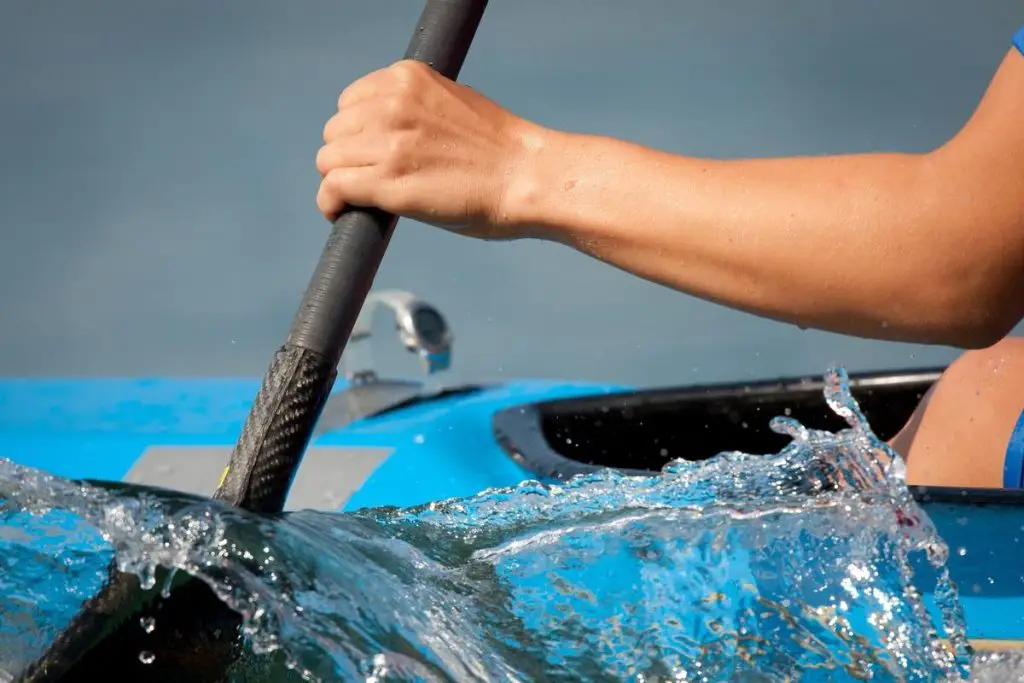Kayak paddles are one of those things that everyone who owns a kayak has to have, but no one ever wants to buy. You might not understand why they are so expensive if you’re a beginner. This equipment is essential for your enjoyment and safety on the water, and it’s not unusual for a new paddler to feel a bit overwhelmed when shopping for theirs.
The most apparent factor that dictates a kayak paddle’s price is the material used to manufacture the shaft and blade. The specific design of these components will also contribute to their price. Carbon fiber tends to be the most expensive material to use. However, it provides the most performance.
Kayak paddles need to fulfill a few criteria. They must be lightweight, have enough surface area to move water and propel the kayak forward, generate speed, and be made of high-quality materials to last a long time. In this article, I’ll explain why a kayak paddle carries such a hefty price tag.

1. Blade and Shaft Material
When it comes to kayak paddles, the material used for the blades and shafts isn’t just about aesthetics. It impacts the function of the paddle. Some kayak paddles are more expensive than others, depending on their manufactured material.
The material that makes up the paddling blade dictates how it performs and various other characteristics such as weight, strength, and durability.
Plastic, fiberglass, and carbon fiber are the most common materials used in kayak paddle blades. At the same time, paddle shafts are typically made from aluminum, fiberglass, or carbon fiber.
As with anything quality made, the materials make all the difference. But while we’d like to think all paddles are made from high-quality, long-lasting materials, the fact is that some cost more than others to offer higher performance and durability.
Fiberglass
Fiberglass blades are typically used for recreational and touring kayaks because they are lightweight, provide lots of power, and have good maneuverability. Although they may vary in price, they’re also the cheapest blades, and you can get one at the low end of below $50.
The fiberglass shaft is heavier than the aluminum one but not as durable as a carbon fiber shaft. Again, it’s most commonly used for recreational purposes.
Carbon Fiber
Carbon fiber is the most expensive yet most popular of all the materials a blade can be made of. It is the strongest and lightest material of them all, making it a favorite of kayakers looking for a paddle that lets them move quickly and easily through the water. Typically, an experienced kayaker will want this blade.
However, as mentioned, carbon fiber is the priciest material to use for the blades. You could expect to pay anywhere around $150 for lower quality and upwards of $500 for exceptional quality.
Carbon fiber shafts are also light and strong compared to their counterparts. They are often used by racers because they are lightweight and offer more flex, but they are not as durable as aluminum.
Plastic Blades
Most entry-level paddles have plastic blades. Plastic is lighter and more flexible than carbon fiber but less durable over time.
The plastic blade is generally in the middle of the park and costs around $100. It is light, semi-durable, and offers more efficiency in the water when compared to fiberglass.
Many people prefer using plastic blades because they are lightweight and have less drag, which helps you move faster with less effort.
These characteristics make them perfect for kayaking because you want to be able to paddle as quickly as possible and still be able to keep your balance.
Aluminum Shafts
The material of the paddle matters when it comes to the feel of the paddle in your hands. While there are several factors to consider when deciding what material to use in your kayak’s shafts, the most important is the amount of money you’re willing to spend.
Aluminum is more robust than carbon fiber but heavier and doesn’t flex as much. It’s the best choice for beginners who want something that will last them a long time without worrying about breaking it.
This shaft material will almost always be cheaper than carbon fiber or fiberglass. However, if you’re looking for an improvement in performance or durability in exchange for your money, there’s plenty of reason to go with carbon fiber.
2. Blade and Shaft Design
Several factors go into the price of any kayak paddle, which can significantly affect how much you end up paying. Blade and shaft designs are such factors – different styles will set you back varying amounts.
Blade designs can vary in shape and size, affecting not only their price but the strength and amount of water resistance they will create. The wider the blade, the more pressure it puts on the water, which creates more resistance.
On the other hand, the thinner a blade is, the less pressure it puts on the water, creating less resistance. Thin blades are lighter and more maneuverable but may not be as strong as thick blades.
Kayak paddle shafts can also vary in design. They can range from straight to bent shafts (which can help with your paddling technique). While both have advantages and disadvantages, a straight shaft is typically cheaper than a bent one.
The price of kayak paddles increases when you add all of these features. Nonetheless, you get a premium product that’s lightweight yet sturdy and efficient, helping you paddle further and faster with less effort.
3. Length of the Paddle
When you’re looking for a paddle, keep in mind that it’s the length of the paddle that matters most. Length is one of the most critical factors in choosing your paddle as it affects your performance on the water.
A longer paddle is heavier and bulkier but gives you more power behind your stroke. Conversely, a shorter paddle is lighter and easier to hold and control, but it won’t give you as much speed or strength to get through choppy or challenging waters.
When choosing a paddle, you should balance your performance needs with your budget. Note that the length of your paddle is one of the most significant contributors to its price. You’ll notice that sometimes even the same brand will have different lengths for the same type of paddle, each costing a different amount.
Longer paddles inherently require more materials to create bigger blades and longer shafts, meaning they are more expensive to manufacture and transport.

Sources
- FlatBottomBoatWorld: How Much Is A Kayak Paddle?
- FunOutdoorVentures: Why Is Kayaking So Expensive? [A Look At The Costs]
- HydroPursuit: Do Kayak Paddles Make That Much of a Difference? (The Facts!)
- OutsideReport: Why Are Kayaks So Expensive? Top Reasons Explained
- Paddling.com: Basic Kayak Paddle Shapes
- Explore-mag: Straight Paddles vs Bent Paddles
